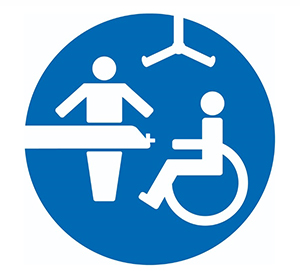
17 June 2024 | Bushboard Washroom Systems Ltd
Toilet Cubicle Regulations: Changing Places Toilets
Changing Places Toilets are designed to to meet the needs of individuals with severe disabilities, read this article to understand who they are for and what is required.
What are Changing Places Toilets?Changing Places toilets are specialised sanitary facilities designed to meet the needs of individuals with severe disabilities who require extra space and specialised equipment to use the toilet and changing. The Changing Places facility is a large room which provides sufficient room for the user and one to two assistants. It also allows the assistant to use the toilet without having to leave the disabled person unattended.
Who are Changing Places Toilets for?
Changing Places Toilets are designed for individuals who are unable to use standard accessible toilets due to their complex needs. It aims to help people who are unable to transfer around the washroom independently or those without sitting balance and so require additional support. This includes people with profound and multiple learning disabilities, conditions affecting movement such as cerebral palsy or multiple sclerosis, severe spinal injuries, stroke survivors, elderly individuals requiring assistance, and ex-service personnel.
What equipment should a Changing Places Toilet provide?
A Changing Places Facility must be equipped with specific features to facilitate safe and efficient use for both users and caregivers. This includes:
- Height adjustable, adult sized changing bench
- Ceiling track hoist system
- Adequate space for the disabled person and up to 2 assistants
- A toilet with space both sides for assistants
- Privacy screen
- Wide paper roll
- Large waste disposal bin
- Washbasin (preferably with adjustable height)
- Back rest on toilet seat
- There are also particular specifications to the sanitaryware that should be provided in Changing Places Toilets.
The Changing Places (CP) Toilet provision should be provided in areas where a large number of people are likely to visit or spend extended periods. CP Toilets should be provided in addition to single or gender-neutral toilets, standard accessible toilets, and baby change facilities. It is generally good practice, if space and funding allows, to include more than one CP toilet if the site is of a larger scale and distance to travel to the washroom is extensive.
The Approved Document M: Volume 2 regulations, which were amended July 2020, asks for at least one Changing Places Toilet provided in certain locations including:
- Places of assembly, recreation and entertainment holding 350 or more people.
- Shopping Centres or retail parks with gross floor area of 30,000 square metres or more.
- Retail premises with a gross floor area of 2500 square metres or more.
- Sports and leisure facilities with a gross floor area of 5000 square metres or more.
- Hospitals and primary care centres.
- Crematoria and cemetery buildings.
Changing Places Toilets should be offered alongside standard washrooms for several reasons. Standard washroom sizes often lack sufficient space for users who require assistance to manoeuvre safely, as well as for powered wheelchairs.
They also typically lack appropriate changing room benching, which means users who need assistance with changing would have to resort to undignified and unhygienic methods, such as lying on the floor. Therefore, offering Changing Places Toilets ensures that all individuals, regardless of their abilities, can access facilities safely and maintain their dignity. Changing Places Toilets should be located in easy